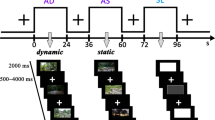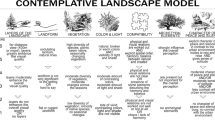Abstract
Neuro-architecture is a specific branch of architecture that studies how the physical environment can change our mental processes and influence our behaviors. One of the main purposes of this field is to use changes in brain activities as a measure to quantify attractiveness of the landscapes. In this study, we investigated how changes in elements of attractiveness influence ones’ emotional perception and present the related pattern of changes in brain activities. Therefore, we implied five elements of attractiveness including mystery, visual openness, landscape or greenness, walkability, and social interaction using the Delphi method. Then, we made changes in each element separately to make the landscape more attractive and assessed their effects on a group of young adults. We used the self-assessment manikin questionnaire to measure the participants’ emotional perception while the participants’ brain activities were recorded using a 32-channel EEG while exposed to the landscape images. The results showed that changes in attractive elements of the landscape could significantly improve ones’ emotional perception of the landscape. In addition, these changes are perceived by changing the oscillatory pattern of brain activities. We hope these findings could shed a light to use of neural markers in measurement of place attractiveness.






Similar content being viewed by others
Data availability
The EEG dataset of all the participants and landscape stimuli are available based on the request to the corresponding author.
References
Acar C, Sakıcı Ç (2008) Assessing landscape perception of urban rocky habitats. Build Environ 43(6):1153–1170
Akiyama M et al (2017) Theta-alpha EEG phase distributions in the frontal area for dissociation of visual and auditory working memory. Sci Rep 7(1):1–11
Amo C et al (2017) Analysis of gamma-band activity from human EEG using empirical mode decomposition. Sensors 17(5):989
Ancora LA et al (2022) Cities and neuroscience research: a systematic literature review. Front Psychiatry 13:983352
Balconi M, Lucchiari C (2008) Consciousness and arousal effects on emotional face processing as revealed by brain oscillations. A gamma band analysis. Int J Psychophysiol 67(1):41–46
Balfour JL, Kaplan GA (2002) Neighborhood environment and loss of physical function in older adults: evidence from the Alameda County Study. Am J Epidemiol 155(6):507–515
Benjamini Y, Hochberg Y (1995) Controlling the false discovery rate: a practical and powerful approach to multiple testing. J Roy Stat Soc Ser B (Methodol) 57(1):289–300
Blume C et al (2015) EEG oscillations reflect the complexity of social interactions in a non-verbal social cognition task using animated triangles. Neuropsychologia 75:330–340
Chang C-Y, Chen P-K (2005) Human response to window views and indoor plants in the workplace. HortScience 40(5):1354–1359
Chatterjee A, Vartanian O (2014) Neuroaesthetics. Trends Cogn Sci 18(7):370–375
Chen C et al (2020) Serial mediation of environmental preference and place attachment in the relationship between perceived street walkability and mood of the elderly. Int J Environ Res Public Health 17(13):4620
Chiang Y-C et al (2017) Wild or tended nature? The effects of landscape location and vegetation density on physiological and psychological responses. Landsc Urban Plan 167:72–83
Choi J-Y et al (2016) Physiological and psychological responses of humans to the index of greenness of an interior space. Complement Ther Med 28:37–43
Dunkel A (2015) Visualizing the perceived environment using crowdsourced photo geodata. Landsc Urban Plan 142:173–186
Ekman P (1999) Basic emotions. Handbook of cognition and emotion. Wiley, USA, pp 45–60
Farashi S, Khosrowabadi R (2020) EEG based emotion recognition using minimum spanning tree. Phys Eng Sci Med 43(3):985–996
Fernandez Rojas R et al (2020) Electroencephalographic workload indicators during teleoperation of an unmanned aerial vehicle shepherding a swarm of unmanned ground vehicles in contested environments. Front Neurosci 14:40
Fong KC et al (2018) A review of epidemiologic studies on greenness and health: updated literature through 2017. Curr Environ Health Rep 5:77–87
Freeman FG et al (1999) Evaluation of an adaptive automation system using three EEG indices with a visual tracking task. Biol Psychol 50(1):61–76
Gehl J (2011) Life between buildings
Gevins A, Smith ME (2003) Neurophysiological measures of cognitive workload during human–computer interaction. Theor Issues Ergon Sci 4(1–2):113–131
Gidlöf-Gunnarsson A, Öhrström E (2007) Noise and well-being in urban residential environments: the potential role of perceived availability to nearby green areas. Landsc Urban Plan 83(2–3):115–126
Güntekin B, Başar E (2010) Event-related beta oscillations are affected by emotional eliciting stimuli. Neurosci Lett 483(3):173–178
Guo M et al (2024) An empirical study on the response of university students to viewing autumn secondary forest phytocommunities landscape via virtual reality in Northeast China. Ecol Indicat 158:111450
Healey JA, Picard RW (2005) Detecting stress during real-world driving tasks using physiological sensors. IEEE Trans Intell Transp Syst 6(2):156–166
Hermes J et al (2018) Assessing the aesthetic quality of landscapes in Germany. Ecosyst Serv 31:296–307
Hoyle H et al (2017) Attractive, climate-adapted and sustainable? Public perception of non-native planting in the designed urban landscape. Landsc Urban Plan 164:49–63
Hume K, Ahtamad M (2013) Physiological responses to and subjective estimates of soundscape elements. Appl Acoust 74(2):275–281
Igarashi M et al (2015) Effect of stimulation by foliage plant display images on prefrontal cortex activity: a comparison with stimulation using actual foliage plants. J Neuroimag 25(1):127–130
Ikemi M (2005) The effects of mystery on preference for residential facades. J Environ Psychol 25(2):167–173
Jasper HH (1958) Report of the committee on methods of clinical examination in electroencephalography: 1957. Electroencephalogr Clin Neurophysiol 10:370–375
Kamzanova AT et al (2014) Use of EEG workload indices for diagnostic monitoring of vigilance decrement. Hum Factors 56(6):1136–1149
Kang J-H et al (2014) Representation of cognitive reappraisal goals in frontal gamma oscillations. PLoS ONE 9(11):e113375
Kaplan R, Kaplan S (1989) The experience of nature: A psychological perspective. Cambridge university press
Karami Z et al (2023a) The Effective factors to increase th visual attractiveness in the everyday landscape (case study: Golabdareh, Tehran). Biannual J Urban Ecol Res
Karami Z et al (2023b) Effects of square attractiveness on emotional perception, cognitive performance, and neurophysiology. Front Architect Res 12(6):1246–1259
Kaźmierczak A (2013) The contribution of local parks to neighbourhood social ties. Landsc Urban Plan 109(1):31–44
Khosrowabadi R (2018) Stress and perception of emotional stimuli: long-term stress rewiring the brain. Basic Clin Neurosci 9(2):107
Kweon B-S et al (2008) Anger and stress: the role of landscape posters in an office setting. Environ Behav 40(3):355–381
Lee J-S, Son K-C (1999) Effects of indoor plant and various colors’ stimuli on the changes of brain activity and emotional responses. J Korean Soc for Horticult Sci 40(6):772–776
Lin W et al (2019) The effect of green space behaviour and per capita area in small urban green spaces on psychophysiological responses. Landsc Urban Plan 192:103637
Lorteije JA et al (2006) Delayed response to animate implied motion in human motion processing areas. J Cogn Neurosci 18(2):158–168
Mackay GJ, Neill JT (2010) The effect of “green exercise” on state anxiety and the role of exercise duration, intensity, and greenness: a quasi-experimental study. Psychol Sport Exerc 11(3):238–245
MacLean MH et al (2012) Resting EEG in alpha and beta bands predicts individual differences in attentional blink magnitude. Brain Cogn 78(3):218–229
Mertens A et al (2021) Pretty crowds are happy crowds: the influence of attractiveness on mood perception. Psychol Res 85:1823–1836
Mikulka PJ et al (2002) Effects of a biocybernetic system on vigilance performance. Hum Factors 44(4):654–664
Misselhorn J et al (2019) Frontal and parietal alpha oscillations reflect attentional modulation of cross-modal matching. Sci Rep 9(1):5030
Morris JD (1995) Observations: SAM: the Self-Assessment Manikin; an efficient cross-cultural measurement of emotional response. J Advert Res 35(6):63–68
Moura F et al (2017) Measuring walkability for distinct pedestrian groups with a participatory assessment method: a case study in Lisbon. Landsc Urban Plan 157:282–296
Nasar JL (1992) Environmental aesthetics: theory, research, and application. Cambridge University Press
Norouzian-Maleki S et al (2015) Developing and testing a framework for the assessment of neighbourhood liveability in two contrasting countries: Iran and Estonia. Ecol Ind 48:263–271
Olszewska-Guizzo A et al (2018) Window view and the brain: effects of floor level and green cover on the alpha and beta rhythms in a passive exposure EEG experiment. Int J Environ Res Public Health 15(11):2358
Pan X, Hamiltonan AFC (2018) Why and how to use virtual reality to study human social interaction: the challenges of exploring a new research landscape. Br J Psychol 109(3):395–417
Paus T et al (1997) Time-related changes in neural systems underlying attention and arousal during the performance of an auditory vigilance task. J Cogn Neurosci 9(3):392–408
Pegors TK et al (2015) Common and unique representations in pFC for face and place attractiveness. J Cogn Neurosci 27(5):959–973
Pope AT et al (1995) Biocybernetic system evaluates indices of operator engagement in automated task. Biol Psychol 40(1–2):187–195
Russell JA, Pratt G (1980) A description of the affective quality attributed to environments. J Pers Soc Psychol 38(2):311
Saleh MAE (2001) Environmental cognition in the vernacular landscape: assessing the aesthetic quality of Al-Alkhalaf village, Southwestern Saudi Arabia. Build Environ 36(8):965–979
Sliwa J, Freiwald WA (2017) A dedicated network for social interaction processing in the primate brain. Science 356(6339):745–749
Thompson CW (2011) Linking landscape and health: the recurring theme. Landsc Urban Plan 99(3–4):187–195
Van der Jagt AP et al (2014) Unearthing the picturesque: the validity of the preference matrix as a measure of landscape aesthetics. Landsc Urban Plan 124:1–13
Van der Wal R et al (2014) The influence of information provision on people’s landscape preferences: a case study on understorey vegetation of deer-browsed woodlands. Landsc Urban Plan 124:129–139
Vecchiato G et al (2015) Electroencephalographic correlates of sensorimotor integration and embodiment during the appreciation of virtual architectural environments. Front Psychol 6:1944
Vytal K, Hamann S (2010) Neuroimaging support for discrete neural correlates of basic emotions: a voxel-based meta-analysis. J Cogn Neurosci 22(12):2864–2885
Wang L et al (2005) On the Euclidean distance of images. IEEE Trans Pattern Anal Mach Intell 27(8):1334–1339
Weinreich A et al (2016) Emotion effects within frontal alpha oscillation in a picture oddball paradigm. Int J Psychophysiol 110:200–206
Weitkamp G et al (2014) Validation of isovist variables as predictors of perceived landscape openness. Landsc Urban Plan 125:140–145
Zhang J et al (2023) Examining the impact of crowding perception on the generation of negative emotions among users of small urban micro public spaces. Sustainability 15(22):16104
Zhou B et al (2017) Places: a 10 million image database for scene recognition. IEEE Trans Pattern Anal Mach Intell 40(6):1452–1464
Zuniga-Teran AA et al (2019) Exploring the influence of neighborhood walkability on the frequency of use of greenspace. Landsc Urban Plan 190:103609
Acknowledgements
We would like to thank Mr. Mohsen Shaabani for his generous help in data gathering stage and all the participants who helped us in this study.
Author information
Authors and Affiliations
Contributions
S A.Y, and R.Kh conceptualized the project. R.Kh, and Z.K designed the experiment. Z.K, and M.K analyzed the data. Z.K and R.Kh wrote the manuscript. S A.Y, and R.Kh supervised the project. R.Kh edited the manuscript.
Corresponding author
Ethics declarations
Ethical approval
The experiment of the present study has been conducted according by the 1964 Helsinki federation and the ethical review board of the institute for cognitive science studies approved the ethics of the experiment with reference number IRB code: IR.SBU.ICBS.97/1027.
Conflict of interests
The authors declare no competing interests.
Additional information
Communicated by Melvyn A. Goodale.
Publisher's Note
Springer Nature remains neutral with regard to jurisdictional claims in published maps and institutional affiliations.
Supplementary Information
Below is the link to the electronic supplementary material.
Rights and permissions
Springer Nature or its licensor (e.g. a society or other partner) holds exclusive rights to this article under a publishing agreement with the author(s) or other rightsholder(s); author self-archiving of the accepted manuscript version of this article is solely governed by the terms of such publishing agreement and applicable law.
About this article
Cite this article
Karami, Z., Yazdanfar, SA., Kashefpour, M. et al. Brain waves and landscape settings: emotional responses to attractiveness. Exp Brain Res (2024). https://doi.org/10.1007/s00221-024-06812-z
Received:
Accepted:
Published:
DOI: https://doi.org/10.1007/s00221-024-06812-z




